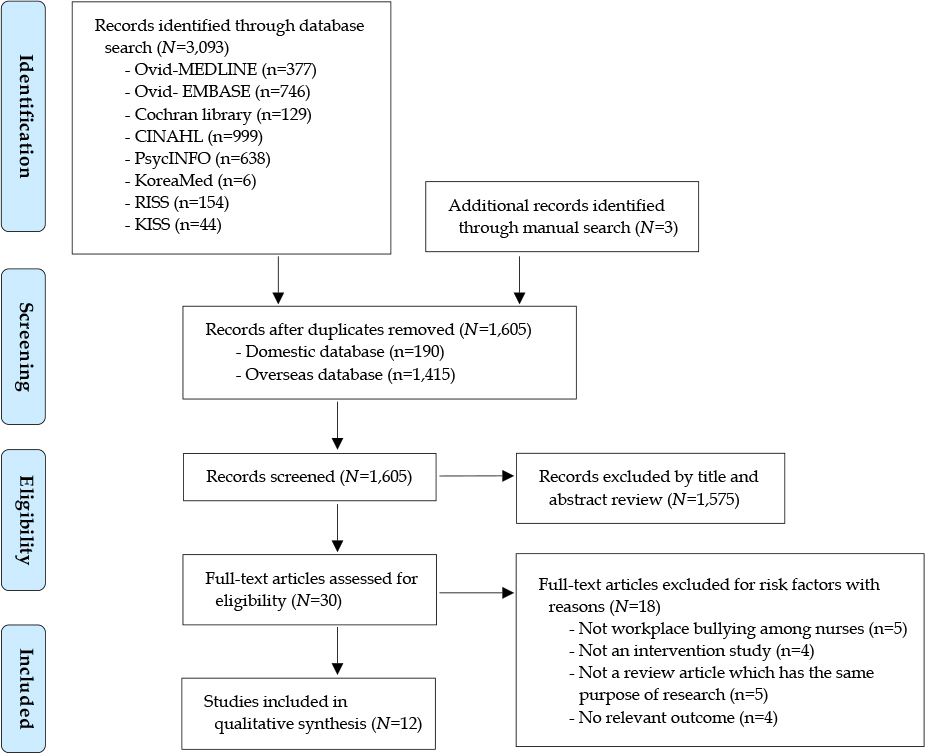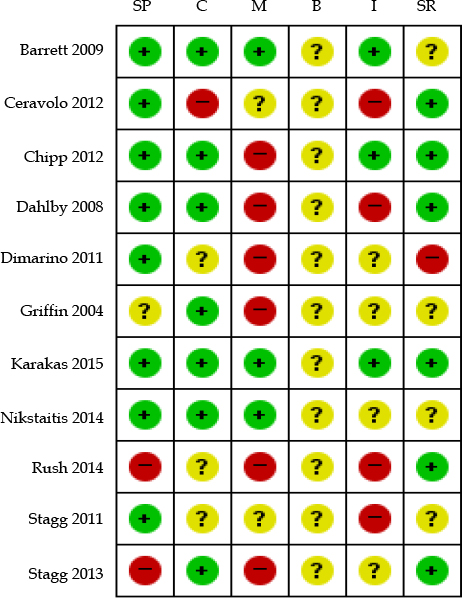J Korean Acad Nurs Adm.
2018 Sep;24(4):339-351. 10.11111/jkana.2018.24.4.339.
Effectiveness of Interventions for Workplace Bullying among Nurses: A Systematic Review
- Affiliations
-
- 1Graduate School, Yonsei University, Korea. hana3270@naver.com
- 2National Evidence-based Healthcare Collaborating Agency, Korea.
- 3Severance Hospital, Korea.
- 4Armed Forces Capital Hospital, Korea.
- 5College of Nursing, Yonsei University, Korea.
- KMID: 2421702
- DOI: http://doi.org/10.11111/jkana.2018.24.4.339
Abstract
- PURPOSE
The aim of this study was to evaluate the effectiveness of interventions for workplace bullying among nurses.
METHODS
First, risk factors of workplace bullying were categorized in order to create analysis criteria. A search of 8 databases, and manual searching resulted in the identification of 3,096 relevant articles. Three of the authors did article selection, data extraction, and quality assessment using the Risk of Bias (RoB) and the Risk of Bias for Nonrandomized studies (ROBANS).
RESULTS
Interventions in workplace bullying were classified as individual, interactions, and organizational approach. Twelve intervention studies (10 individual interventions, 1 team approach, 1 multi-level approach) were selected. Four of the individual interventions decreased bullying, but three had no effect. One multi-level intervention reported that bullying did not occur. Individual interventions improved bullying awareness in four articles, decreased turnover intention in two articles, and increased skill and knowledge of bullying management in five articles. One team approach increased nurse interactions and group cohesion. The quality of selected articles was low overall.
CONCLUSION
Individual interventions have a possibility to improve awareness and knowledge about bullying, but there is a lack of evidence on preventing bullying. Further research is required on multi-levels interventions with well-designed controlled trials.
Keyword
Figure
Cited by 2 articles
-
Response Patterns of Nursing Unit Managers regarding Workplace Bullying: A Q Methodology Approach
Jin Kyu Choi, Byoungsook Lee
J Korean Acad Nurs. 2019;49(5):562-574. doi: 10.4040/jkan.2019.49.5.562.Dis-eases of Korean nurses: a women’s health perspective
Moon Jeong Kim
Korean J Women Health Nurs. 2021;27(4):268-271. doi: 10.4069/kjwhn.2021.12.07.
Reference
-
1. Coursey JH, Rodriguez RE, Dieckmann LS, Austin PN. Successful implementation of policies addressing lateral violence. AORN J. 2013; 97(1):101–109. DOI: 10.1016/j.aorn.2012.09.010.
Article2. Einarsen Sl, Hoel H, Zapf D, Cooper CL. The concept of bullying at work: The European tradition. In : Einarsen S, editor. Bullying and emotional abuse in the workplace International Perspectives in Research and Practice. New York: Taylor & Francis;2003. p. 3–30.3. Dieter Z. Organisational, work group related and personal causes of mobbing/bullying at work. Int J Manpow. 1999; 20(1/2):70–85. DOI: 10.1108/01437729910268669.4. Einarsen S. Harassment and bullying at work: A review of the Scandinavian approach. Aggress Violent Behav. 2000; 5(4):379–401. DOI: 10.1016/S1359-1789(98)00043-3.5. Lee Y, Lee M, Bernstein K. Effect of workplace bullying and job stress on turnover intention in hospital nurses. J Korean Acad Psychiatr Ment Health Nurs. 2013; 22(2):77–87. DOI: 10.12934/jkpmhn.2013.22.2.77.
Article6. Hutchinson M, Vickers M, Jackson D, Wilkes L. Workplace bullying in nursing: Towards a more critical organisational perspective. Nurs Inq. 2006; 13(2):118–126.
Article7. Johnston M, Phanhtharath P, Jackson BS. The bullying aspect of workplace violence in nursing. JONAS Healthc Law Ethics Regul. 2010; 12(2):36–42.
Article8. Gu MY, Cheon JY, Seo YT, Jung SK. Prevention of workplace bullying among women workers. Survey analysis and policy suggestions. Seoul: Korean Women's Development Institute;2015. Report No.: 2015-28.9. Hutchinson M, Wilkes L, Jackson D, Vickers MH. Integrating individual, work group and organizational factors: Testing a multidimensional model of bullying in the nursing workplace. J Nurs Manag. 2010; 18(2):173–181. DOI: 10.1111/j.1365-2834.2009.01035.x.
Article10. Johnson SL. International perspectives on workplace bullying among nurses: A review. Int Nurs Rev. 2009; 56(1):34–40. DOI: 10.1111/j.1466-7657.2008.00679.x.
Article11. Quine L. Workplace bullying in nurses. J Health Psychol. 2001; 6(1):73–84. DOI: 10.1177/135910530100600106.
Article12. Kang JY, Lee MJ. Pooled prevalence of workplace bullying in nursing: Systematic review and meta-analysis. J Korean Crit Care Nurs. 2016; 9(1):51–65.13. Griffin M. Teaching cognitive rehearsal as a shield for lateral violence: An intervention for newly licensed nurses. J Contin Educ Nurs. 2004; 35(6):257–263. DOI: 10.3928/0022-0124-20041101-07.
Article14. Kang J, Lee M. The related factors to workplace bullying in nursing: A systematic review and meta-analysis. Korean J Adult Nurs. 2016; 28(4):399–414.
Article15. Parker KM, Harrington A, Smith CM, Sellers KF, Millenbach L. Creating a nurse-led culture to minimize horizontal violence in the acute care setting: A multi-interventional approach. J Nurses Prof Dev. 2016; 32(2):56–63.16. Karakas SA, Okanli A. The effect of assertiveness training on the mobbing that nurses experience. Workplace Health Saf. 2015; 63(10):446–451.
Article17. Rush KL, Adamack M, Gordon J, Janke R. New graduate nurse transition programs: Relationships with bullying and access to support. Contemp Nurse. 2014; 48(2):219–228.
Article18. Stagg SJ, Sheridan D. Effectiveness of bullying and violence prevention programs. AAOHN J. 2010; 58(10):419–424. DOI: 10.3928/08910162-20100916-02.
Article19. Moher D, Shamseer L, Clarke M, Ghersi D, Liberati A, Petticrew M, et al. Preferred reporting items for systematic review and meta-analysis protocols (PRISMA-P) 2015 statement. Syst Rev. 2015; 4(1):1–9. DOI: 10.1186/2046-4053-4-1.
Article20. Higgins JPT, Green S, editors. Cochrane handbook for systematic reviews of interventions version 5.1.0. The Cochrane Collaboration;2011. updated March 2011. cited May 20, 2018. Available from: http://handbook-5-1.cochrane.org/.21. Bidwell S, Jensen MF, editors. Etext on Health Technology Assessment (HTA) Information Resources. Chapter 3: Using a Search Protocol to Identify Sources of Information: The COSI Model [Internet]. Bethesda, MD: U.S. National Library of Medicine;2003. updated June 14, 2003. cited August 8, 2018. Available from: https://www.nlm.nih.gov/archive/20060905/nichsr/ehta/chapter3.html#COSI.22. Kim SY, Park JE, Seo HJ, Seo HS, Son HJ, Shin CM, et al. NECA's guidance for undertaking systematic reviews and meta-analyses for intervention. Seoul: National Evidence-based Health Care Collaborating Agency;2011. p. 65–91.23. Koh WMS. Management of work place bullying in hospital: A review of the use of cognitive rehearsal as an alternative management strategy. Int J Nurs Sci. 2016; 3(2):213–222. DOI: 10.1016/j.ijnss.2016.04.010.24. Illing J, Carter M, Thompson NJ, Crampton PES, Morrow GM, Howse JH, et al. Evidence synthesis on the occurrence, causes, consequences, prevention and management of bullying and harassing behaviours to inform decision-making in the NHS. Final report. London: Durham University;2013. 02. Report No.: 10/1012/01.25. Salin D. Ways of explaining workplace bullying: A review of enabling, motivating and precipitating structures and processes in the work environment. Hum Relat. 2003; 56(10):1213–1232. DOI: 10.1177/00187267035610003.26. Kang J, Kim JI, Yun S. Effects of a cognitive rehearsal program on interpersonal relationships, workplace bullying, symptom experience, and turnover intention among nurses: A randomized controlled trial. J Korean Acad Nurs. 2017; 47(5):689–699. DOI: 10.4040/jkan.2017.47.5.689.
Article27. Nikstaitis T, Simko LC. Incivility among intensive care nurses: The effects of an educational intervention. Dimens Crit Care Nurs. 2014; 33(5):293–301. DOI: 10.1097/DCC.0000000000000061.28. Stagg SJ, Sheridan DJ, Jones RA, Speroni KG. Workplace bullying: The effectiveness of a workplace program. Workplace Health Saf. 2013; 61(8):333–338. DOI: 10.1177/216507991306100803.
Article29. Ceravolo DJ, Schwartz DG, Foltz-Ramos KM, Castner J. Strengthening communication to overcome lateral violence. J Nurs Manag. 2012; 20(5):599–606.
Article30. Chipps EM, McRury M. The development of an educational intervention to address workplace bullying: A pilot study. J Nurses Staff Dev. 2012; 28(3):94–98. DOI: 10.1097/NND.0b013e31825514bb.31. Dimarino TJ. Eliminating lateral violence in the ambulatory setting: One center's strategies. AORN J. 2011; 93(5):583–583. DOI: 10.1016/j.aorn.2010.10.019.
Article32. Stagg SJ, Sheridan D, Jones RA, Speroni KG. Evaluation of a workplace bullying cognitive rehearsal program in a hospital setting. J Contin Educ Nurs. 2011; 42(9):395–403. DOI: 10.3928/00220124-20110823-22.
Article33. Barrett A, Piatek C, Korber S, Padula C. Lessons learned from a lateral violence and team-building intervention. Nurs Adm Q. 2009; 33(4):342–351. DOI: 10.1097/NAQ.0b013e3181b9de0b.
Article34. Dahlby MA, Herrick LM. Evaluating an educational intervention on lateral violence. J Contin Educ Nurs. 2014; 45(8):344–350. DOI: 10.3928/00220124-20140724-15.
Article35. Ramsay S, Troth A, Branch S. Work place bullying: A group processes framework. J Occup Organ Psychol. 2011; 84(4):799–816.36. Ganz FD, Levy H, Khalaila R, Arad D, Bennaroch K, Kolpak O, et al. Bullying and its prevention among intensive care nurses. J Nurs Scholarsh. 2015; 47(6):505–511. DOI: 10.1111/jnu.12167.
Article
- Full Text Links
- Actions
-
Cited
- CITED
-
- Close
- Share
- Similar articles
-
- Factors Affecting Workplace Bullying in Korean Hospital Nurses
- Relationships among Self-esteem, Social Support, Nursing Organizational Culture, Experience of Workplace Bullying, and Consequence of Workplace Bullying in Hospital Nurses
- Effects of Organizational Silence and Organizational Justice on Bullying among Hospital Nurses at Work
- Relationship between Organizational Culture and Workplace Bullying among Korean Nurses
- Moderating effects of Professional Self-concept in Relationship between Workplace Bullying and Nursing Service Quality among Hospital Nurses



